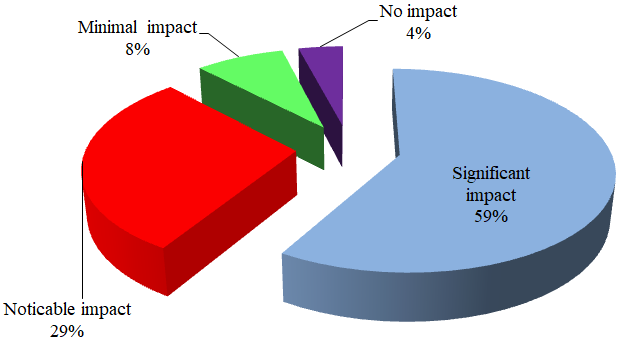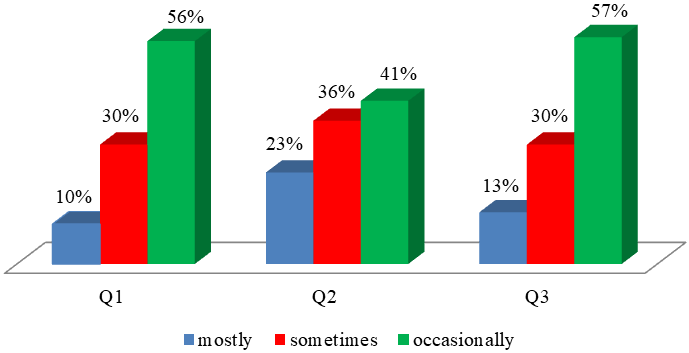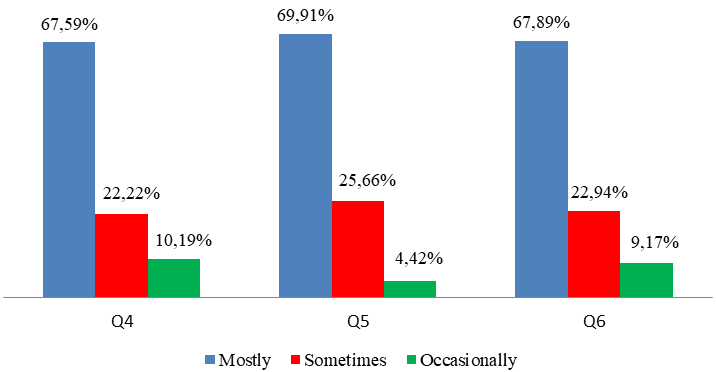THE SHIFTING ATTITUDE IN MONGOLIAN UNIVERSITY STUDENTS DURING A GLOBAL PANDEMIC
ИЗМЕНЯЮЩЕЕСЯ ОТНОШЕНИЕ СТУДЕНТОВ МОНГОЛЬСКОГО УНИВЕРСИТЕТА В ПЕРИОД ГЛОБАЛЬНОЙ ПАНДЕМИИ
Научная статъя
Цэрэндулам Ш.1, Болор Б.2, *, Ариунаа Ж.3
1, 2, 3 Государственный Университет Монголии, Улан-Батор, Монголия
* Корреспондирующий автор (bbolor_21[at]yahoo.com)
АннотацияКовид-19 необратимо меняет отношение, мнение и жизнь человечества. Сегодня мы чувствуем и видим, что пандемия ковид-19, которая впервые начала распростняться в период с 2019 по 2020 год, оказывает сильное влияние на все секторы экономики, включая образование. Из-за пандемии ускорился процесс четвертой революции промышленности, и жизнь человечества стала тесно связана с диджитал-миром.
Глобализация и сегодняшние экономические и социальные тенденции резко изменяют характеристики нынешних и будущих студентов, создав концепцию “новые нормальные студенты”.
Тема того, как ковид-19 повлиял на отношение студентов, как важный аспект университета, привлекает внимание исследователей.
Цель этого исследования–выявить изменение отношения студентов, живущих и работающих при условиях пандемии ковид -19.
Ключевые слова: новые нормальные студенты, образование, пандемия ковид-19.
THE SHIFTING ATTITUDE IN MONGOLIAN UNIVERSITY STUDENTS DURING A GLOBAL PANDEMIC
Research article
Tserendulam Sh.1, Bolor B.2, *, Ariunaa J.3
1, 2, 3 National University of Mongolia, Ulan-Bator, Mongolia
* Corresponding author (bbolor_21[at]yahoo.com)
Abstract
The COVID-19 virus is irreversibly altering humanity’s opinions, attitudes, and lives. Ever since it began to spread in late 2019 and early 2020, COVID-19 has affected all parts of society, especially the educational sector. The pandemic has hastened the effect of the fourth industrial revolution, plunging us deeper into the grasp of the internet and modern technology. With the changes in globalization, society, and the characteristics of current college students, as well as future college students, the concept of “New Normal Students” has emerged. The pandemic has sped up the changes in students. The topic of how students’ characteristics, an important aspect of university, have been affected by COVID-19 is catching the attention of researchers.
We have gathered information and observed how the overall attitude and state of mind of students have shifted.
Keywords: new normal student, education, COVID-19 pandemic.
IntroductionOne of the most recent public health emergencies of global concern is the recent COVID-19 pandemic, which started in China and almost infected every country in the whole world. This disease is caused by a novel corona virus (SARA-CoV-2, previously known as 2019-nCoV) and has received global attention from growing infections and on how to eradicate the disease and flatten the curve of infections [1]. Symptoms include cough, fever and shortness of breath which can be transferred through close contact with an infected person be coughing, sneezing, respiratory droplets or aerosols [2]. Though it affects people of all ages, it is most vulnerable to adults, children and people with underlying medical conditions [3]. As of this time, the number of infections and deaths is still increasing worldwide. In order to avoid the infection, containment, mitigation, contact tracing, self-isolation, social distancing, wearing of face masks, improved health care systems, hand-washing and surface cleaning is recommended by the World Health Organization [3].
The fight against the threats to COVID-19 pandemic suffered profound effects and impacts on almost all sectors in the human race. These have resulted in the widespread disruption such as travel restrictions, closure of schools, global economic recession, political conflicts, racism and misinformation and controversies [4], to name a few. One of the most affected is the educational sectors. For almost pandemic years, most countries around the world have temporarily closed educational institutions to contain the spread of the COVID-19 pandemic and reduce infections. This closure has affected more than 1.2 billion learners worldwide [5]. Responses like community lockdown and quarantine of several countries have led students and teachers to study and work from home which led to the delivery of online learning platforms [6]. At this time each higher education institute has focused on immediate challenges, namely, managing the health, welfare, safety and financial impacts of the COVID-19 crisis on students, faculty and staff, and other key stakeholders.
In recent years, the global, economic, and societal trends have also dramatically shifted the attributes of students seeking higher education. These new normal students may already be working or have families [7], and may need access to non-academic services such as childcare and financial assistance to meet their work and family obligations as they take courses and study. They may also need flexible schedules, including courses they can complete at their own pace, faster or slower, depending on their obligations. Modularized content can enable them to engage in short bursts of study such as during lunch hours or work breaks.
The wellbeing of university students has been widely studied, and high levels of depression, anxiety, and stress have been reported by undergraduate students [8]. These variables were, therefore, included in the Student WPQ. Positive and negative wellbeing are not just opposite ends of a single dimension, which meant that positive outcomes (happiness, life satisfaction and positive affect) were also included in the questionnaire. Student related stressors have been widely studied and include fear of failing and long hours of study, social demands [9] and lack of social support.
From the moment COVID-19 became a global threat, the Mongolian government took action. By closing the borders, halting flights, quarinting newly arrived citizens, and regulating how much citizens can go outside, Mongolia was able to maintain a low number of cases for a year. Due to the aforementioned regulations, a number changes were made regarding the educational system:
- As Mongolia has been deemed to be at high risk, the functions all levels of the education system will be halted. This decision was made on January 27th.
- Due to the nationwide quarantine, higher education had been restricted to online classes on February 2nd, 2020 until further notice. Because the situation had not improved, the online-only classes continued until the end of the Spring semester [10].
- Although worldwide progress towards developing a vaccine has been in motion, the details of when the populous could be vaccinated was unclear. By September 1st, 2020, classes were still exclusively being taught online. [10]
- Recognizing that COVID-19 had not been spreading locally, the Mongolian government allowed the continuation of classes in person starting on September 21 [11].
- However, on November 11th, local cases of COVID-19 had been confirmed. The Emergency Committee announced a nationwide state of high alert and, consequently, classes reverted back to online platforms [12].
- Since the first confirmed case of local infection, there had been 3 instances of nationwide regulation. From February 23rd, 2021, vaccination protocol had started (UNICEF 2021), setting goals to vaccinate the adult population in the capital by June 1st, and the rest of the country’s adult population by July.
- During the time of Mongolia’s traditional Lunar New Year, more specifically between February 11th and February 23rd, 2021, the government imposed heavy restrictions, later downgrading from disaster prevention grade alert to daily high alert. At this time, appeals were made to the Ministry of Education and Science to continue in-person classes step-by-step. With the permission of the Ministry of Education and Science, primary and secondary school in-person classes in the provinces started on March 1st.
- Mid-March, there was a noticeable increase in cases and rate of infection within the capital city of Ulaanbaatar. There were also confirmed cases of COVID-19 in the provinces. The Mongolian government, in response, increased restrictions and level of alert starting from April 3rd to April 19th, 2020 Once again, all levels of education had been restricted to online platforms [14].
- Due to the pandemic, university students in Mongolia have exclusively been studying online since February 2020 for 3 semesters.
We conducted a survey was in order to assess the changes and shifts in attitude of Mongolian University students during the current pandemic. 108 undergraduates and 85 graduate students participated in the survey. Consequently, 35% of the respondents said they were male, 65% were female, 70% were employed, 82% were married and 9% will be getting married soon. 51% of working students have a full-time job, 34 of married students have one child and 1% have two children.
The survey was presented online using Microsoft Forms. Most of the questionnaires are taken from the version used by Andrew Smith in his research. The additional questions measured student stressors, the impact of COVID-19 pandemic on student life. Participants answered on a scale of 1-10, with 1 being total disagreement and 10 being total agreement. The survey indicated a 0.76 Cronbach’s alpha (a test score reliability coefficient), the test passes as reliable.
Figure 1 illustrates the results of the question “Has the COVID-19 pandemic caused stress and or dissatisfaction pertaining to your university experience?”
Fig. 1 – Students' attitude of the COVID-19 pandemic's impact
"The current situation caused by the COVID-19 pandemic has had a profound effect on my life," said the students, who have full-time or part-time jobs, 32% of whom are female. "I'm very stressed," said 26% of those surveyed, and 81% said "the COVID-19 pandemic is having a huge impact on my life". 47 percent of those surveyed said they were "somewhat stressed" and 57% said "the situation caused by the COVID-19 pandemic is having a huge impact on my life".
The survey participants’ self-analysis results are shown in Table 1.
Table 1 – Comparison of survey answers
| Question | Average | SD |
| Overall, I feel that I have low self-esteem | 4.75 | 1.94 |
| On a scale of one to ten, how depressed would you say you are in general? | 5.09 | 2.17 |
| I have been feeling good about my relationships with others | 7.31 | 2.02 |
| I don't really get on well with people | 3.51 | 2.08 |
| Thinking about myself and how I normally feel, in general, I mostly experience positive feelings | 7.03 | 1.94 |
| In general, I feel optimistic about the future | 7.83 | 2.05 |
| I am confident in my ability to solve problems that I might face in life | 7.79 | 1.93 |
| I feel that I am laid-back about things | 5.81 | 2.35 |
| I am not interested in new ideas | 3.79 | 2.01 |
| Overall, I feel that I have positive self-esteem | 7.40 | 1.86 |
| I feel that I have the social support I need | 7.75 | 2.14 |
| Thinking about myself and how I normally feel, in general, I mostly experience negative feelings | 4.08 | 1.96 |
| I feel that I have a disagreeable nature | 3.39 | 2.13 |
The results of the answers to the question regarding how the participant feels positively about themselves range from 7.03 to 7.83, meaning the participants generally feel good about themselves.
The following three questions were answered to determine the cause of the stress.
Q1. Challenges to your development (e.g., important decisions about your education and future career, dissatisfaction with your written or mathematical ability, struggling to meet your own or others’ academic standards)
Q2. Time pressures (e.g., too many things to do at once, interruptions of your school work, a lot of responsibilities).
Q3. Academic Dissatisfaction (e.g., disliking your studies, finding courses uninteresting, dissatisfaction with school)
In the figure 2 demonstrated causes of stress for students at university.
Fig. 2 – Causes of stress for students at university
Commonly cited reasons for stress are having too many tasks at the same time, having to skip classes, and generally feeling pressured due to a lack of time resulting from an overall increase in responsibility.
The following questions concern the people that show support to the participants.
Q1. There is a person or people in my life who would provide tangible support for me when I need it.
Q2. There is a person or people in my life who would provide me with a sense of belonging.
Q3. There is a person or people in my life with whom I would feel perfectly comfortable discussing any problems I might have.
The results of the above questions are shown in Figure 3.
Fig. 3 – Factors that affect the participant’s emotional and mental state positively
Figure 3 shows that, although there is a considerable increase in stress due to the COVID-19 pandemic, there is ample support from friends and family.
Although the general consensus reached by the survey is that there is an overall decline in happiness and increase in stress, the following are contrasting data derived from a new survey involving graduate students that inquire about the positive effects of the status quo.
- An increase in the usage of new technology, platforms that are designed for education, and incentive/opportunity to promote technical proficiency.
- Time freed up to use productively instead of being wasted due to commuting delays.
- Newfound appreciation and understanding of the importance of interpersonal physical interaction, and an opportunity to spend time with family members.
- Time to self-actualize, understanding that there are always ways to cope as well as solve problems in life.
- Opportunities to focus on healthy habits, improving one’s diet, and exercise.
- Newly gained confidence and mental fortitude to deal with difficulty.
- Benefits of working from home, ability to spend time with their children, and a doubling in enrollment to the National University of Mongolia’s graduate program.
Much like how Mongolia’s economy has taken a hit due to the pandemic, educational institutions have also had difficulties coping with the unprecedented need to quarantine. Although there are negatives readily noted by students that have moved online, there are also accompanying positives.
The changes that the global pandemic brings shine light on issues such as the need to adapt to a rapidly developing world of technology.
The education sector is one of the most affected sectors. Therefore, schools need to adapt and adopt new norms. With the increasing COVID-19 cases in Mongolia, this study looks at developing norms observed in students.
Students of the National University of Mongolia await necessary policy from the ministry of education to ensure the integrity and efficacy of educational development programs during the pandemic.
| Конфликт интересов Не указан. | Conflict of Interest None declared. |
Список литературы / References
- Guo Y.R. The origin, transmission and clinical therapies on coronovirus disease 2019 (COVID-19) outbreak an update on the status / R Guo et al. // Melitary Medical Research. - 2020
- Shereen M. A. COVID-19 ifection: Origin, transmission, and characteristics of human coronoviruses / A Shereen et al. // Journal of Advanced Research. - 2020
- / Coronovirus disease 2019 (COVID-19) Situation Report - 51 - 2020.
- Entan S. The 2019 novel Corovavirus Outbreak: Current Crises, Controversies and Global Strategies to Prevent a Pandemic / S Entan et al. // International Journal of Pathogen Research. - 2020
- UNESCO / COVID-19 Educational Disruption and Response - 2020. [Electronic resource]. URL: http://en.unesco.org/covid19/educationresponse. (accessed 12.04.2021)
- Crawford J. COVID-19: 20 countries' higher education intra-period digital pedagogy responses / J Crawford et al. // Journal of Applied Learning & Teaching. - 2020
- National Center for Education Statistics. Demographic and enrollment characteristics of nontraditional undergraduates: 2011-2012. - 2015. [Electronic resource]. URL: http://nces.ed.gov/pubs2015/2015025.pdf. (accessed 12.04.2021)
- Bayram N. The prevalence and socio-demographic correlations of depression, anxiety and stress / N. Bayram et al. // Soc. Psychiatry. Psychiatr. Epidemiol. -
- Andrew P. S. Student workload, wellbeing and academic attainment / P. S. Andrew // Centre for Occupational and Health Psychology. -
- mn. // [Electronic resource]. URL: https://www.legalinfo.mn/law/details. 26 1 2020. (accessed 12.04.2021)
- Meds / meds.gov.mn, - 8 - 2020. [Electronic resource]. URL: https://www.meds.gov.mn/?p=5138. (accessed 12.04.2021)
- // National Emargancy Management Agency. - 21- 12- 2020. [Electronic resource]. URL: https://nema.gov.mn/wp-content/uploads/2020/12/%D0%A2%D0%BE%D0%B3%D1%82%D0%BE%D0%BE%D0%BB.pdf.
- // www.unicef.org. - 12 - 3 - 2021. [Electronic resource]. URL: https://www.unicef.org/mongolia/mn/press-releases/mongolia-welcomes-first-batch-covid-19-vaccines-covax-facility. (accessed 12.04.2021)
- // National Emargancy Management Agency. - 3 - 2021. [Electronic resource]. URL: http://en.nema.gov.mn/.(accessed 12.04.2021)



